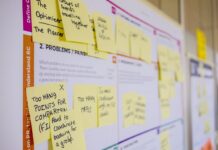Today you’re going to learn how to prepare for a client meeting or with coworkers.
Different professional meetings can vary in tone, setting, formality, and content. However, regardless of the type of meeting, it is crucial to be well-prepared.
To make a positive and professional impression on your colleagues or clients, you should understand your role in the meeting, determine your objectives, gather relevant data and presentation materials, and mentally prepare yourself beforehand.
How To Prepare For a Client Meeting or With Coworkers:
1. Confirm the meeting details with a manager
Before sharing meeting information with the relevant individuals, ensure that you have accurate information about the meeting’s time, location, and duration. Failing to do so may result in having to correct the information later, which reflects poorly on you and your office’s organization and professionalism.
It is advisable to share a draft of the meeting announcement memo or email with your manager, so they can review the logistical details as well as the format and wording. Additionally, confirm who should receive the announcement to include non-attending workers or clients if required.
2. Prepare an agenda for the meeting
An agenda is a vital document that informs attendees about the meeting’s objectives and scope, while also keeping the discussion focused, efficient, and on track. To create an agenda, consult your manager for a list of objectives and planned topics for the meeting.
Based on this information, develop an agenda that you will distribute along with the meeting notification. A well-crafted agenda should include the topics to be addressed, their purposes, and the responsible speakers or personnel for each topic.
Organize the topics in a logical sequence and allocate time slots as per your manager’s instructions. If you need assistance in creating an agenda, you can explore templates available in word processing programs like Microsoft Word and OpenOffice.
3. Gather minutes from previous meetings
Alongside the meeting notification and agenda, include any relevant minutes from previous meetings. If your company or group does not maintain minutes, consult your manager to determine if there is any additional data or background information that should be shared with the notification. If minutes are not typically taken, consider revising this policy for future meetings or at least recording the meeting audio to provide a reference for attendees who couldn’t be present.
4. Distribute all documents
Approximately one week before the scheduled meeting, distribute all the necessary documents to attendees and other relevant individuals. Follow your company’s protocol for distribution, which may involve sending hard copies for formal meetings or larger companies, while email may suffice for smaller companies or more informal team meetings.
Utilize software and email platforms like Outlook (1), which can facilitate meeting scheduling and streamline your office’s meeting calendar. Be aware that specific organizations and professional protocols may have their own deadlines and terms for distributing meeting notices.
5. Gather the required equipment
Depending on the nature of the meeting, you may need various equipment and materials beyond tables, chairs, and note-taking supplies. Larger companies or meetings involving data- or multimedia-heavy presentations might require projectors, screens, laser pointers, microphones, cable hook-ups, or audio speakers.
Collect and assemble all the necessary equipment well in advance to ensure everything is functioning and ready on time. If employees or team members plan to present during the meeting, reach out to them beforehand to determine if they need specific technology or devices for their presentations.
6. Set up the meeting room
In addition to arranging all the necessary equipment well in advance of the meeting, it is essential to ensure that the room is conducive to everyone’s comfort and attentiveness. Pay attention to details that contribute to a pleasant environment, such as ensuring an adequate number of chairs, visible and stocked water bottles, and appropriate temperature and air circulation. While these may seem like minor considerations, research has demonstrated that factors like room temperature can significantly impact people’s moods and engagement levels.
Depending on your company’s customary practices, you may also consider providing refreshments such as snacks or hot beverages for the attendees. It’s always important to confirm with your manager beforehand to ensure that you are meeting their specific requirements and preferences.
7. Familiarize yourself with your role
Before attending a meeting, especially if you have a specific project or idea to present, it is essential to thoroughly research and understand the topic. For example, if you’re pitching a product or marketing strategy, gather data on audience demographics, spending patterns, and relevant surveys.
If you’re unsure about your assigned task, seek guidance from senior employees to clarify expectations and the information you should gather. Put yourself in the shoes of the audience and consider the information that would persuade you if you were in their position.
8. Create visually appealing materials
While you should be able to verbally explain the data you’re presenting, incorporating visual representations such as graphs, charts, or decision trees can enhance clarity and memorability. Utilize software like PowerPoint or Canva (2) to design engaging presentations. Ensure that the font size is large enough (minimum 24 points) and that the graphics are clear and uncluttered, allowing the audience to easily understand the information.
9. Tailor your language and materials to the audience
Consider the composition of the audience when planning your presentation. If they are your close team members, you may not need to adjust your language or tone significantly. However, if the attendees include clients or individuals from different departments or areas of expertise, make an effort to make your language and materials accessible and understandable to a broader audience.
10. Prepare a loose script
Although you should avoid reading from a document during the meeting, it is beneficial to organize your thoughts and arguments in written form beforehand. Even if you don’t bring the script with you, writing and reviewing your points in advance will help you effectively communicate them to others.
If you decide to use a script during the meeting, outline the main points to prevent reliance on reading verbatim. Note any intervals for pauses, water breaks, anecdotes, or slide transitions.
11. Rehearse your presentation
Once you have gathered all the necessary information and prepared your presentation materials, practice delivering your presentation at least once. This allows you to refine your timing, practice transitions and wording, and improve your overall presentation skills. It is beneficial to rehearse in front of others, such as friends, family, or colleagues, who can provide feedback on your delivery, clarity, and gestures.
12. Dress professionally
Regardless of the level of formality in your company or among clients, it is important to dress smartly for meetings. Your attire should demonstrate that you take the meeting seriously and have made the effort to prepare.
A suit is generally considered a safe and appropriate choice, opting for dark colors such as navy or black. If the meeting is more informal, you can adjust the dress code accordingly, but still maintain a professional appearance. Seek advice from friends or family if you need help with outfit selection or consider purchasing suitable attire if necessary.
13. Wake up early
Avoid rushing and feeling frazzled by waking up and allowing ample time before the meeting. By taking your time to get ready, have a coffee, and go through your morning routine in a relaxed manner, you can clear your mind and focus on the upcoming meeting. Engaging in personal rituals or routines, even if they seem superstitious, can have a positive impact on your performance and mindset.
14. Have a protein-rich breakfast
Eating a nutritious breakfast, particularly one that includes protein, has been shown to have positive effects on energy levels, metabolism, and cognitive function. A breakfast containing foods rich in flax and folic acid can stimulate brain function, leading to improved speech fluency and creativity during the meeting. Include protein sources and consider cereals or breakfast bars with beneficial nutrients.
15. Foster a positive mindset:
After completing all the necessary preparations for your presentation, it’s crucial to cultivate a positive mental state. Take a moment to go through your presentation in a quick review, but focus primarily on uplifting your mood and boosting your confidence. Engage in positive self-talk, reminding yourself of the extensive work you’ve put in and how proud you are of your efforts, regardless of the meeting’s outcome.
Furthermore, visualize yourself with a smile on your face, feeling relieved and joyful after successfully delivering the presentation. This positive imagery can significantly influence your performance, helping you project confidence and perform at your best.
16. Seek an informational meeting with a professional contact
If you come across someone who holds a desirable position in your industry of interest or have connections with individuals at the company where you’re interning, it can be beneficial to arrange an informational meeting with them. An informational meeting, also known as an informational interview, involves having a conversation with a contact who can serve as a valuable professional resource. This gives you the opportunity to inquire about their experiences, their field, and seek advice on entering the industry.
When considering whom to approach for an interview or whether a specific person would be suitable, take a moment to outline your objectives and the type of information you are seeking. This process will help you identify potential interviewees who align with your goals and determine if a particular contact can provide the assistance you need.
17. Request a meeting
When reaching out to a contact or acquaintance for an informational interview, it is important to clearly state that you are seeking an “informational meeting” or “informational interview.” By explicitly mentioning this, you avoid any misunderstandings where the person may expect a casual chat or informal gathering and feel surprised or caught off guard when you begin discussing serious topics.
For example, if you have met someone at a party or networking event and had a brief conversation, you can say something like, “I have numerous questions about your field and your experiences. Would you be willing to meet over coffee for an informational meeting?”
If you don’t have the opportunity to ask them in person, you can reach out via email or phone. Ensure your message is concise and polite to prevent the contact from feeling burdened by your request.
18. Select a convenient setting and time for your contact
While the individual you are approaching may be willing to help, it’s important to remember that they are doing you a favor by taking time out of their workday for the informational meeting. Therefore, it is crucial to make the meeting as convenient as possible, respecting their time and limiting the meeting to around 15-30 minutes.
Consult with your interviewee to determine the best time of day, such as during their lunch break or after work, and their preferred meeting location, such as a coffee shop or their office. Additionally, make it known that you are open to conducting the meeting through phone or online platforms if an in-person meeting is not feasible. This consideration demonstrates your respect for their time and willingness to accept any level of assistance they are willing to provide.
19. Conduct thorough research
Once you have arranged a meeting with your contact, make an effort to gather as much information as possible about their background. This will help you approach the meeting more effectively and identify specific areas from which they can provide insights. For instance, find out about their career path, current projects, and primary roles.
Asking specific questions based on your research will also showcase your interest and enthusiasm. Avoid excessive flattery but consider asking something like, “I heard from my previous manager that you have valuable experience in turning passion projects into successful ventures. How did you initially get started?” Such questions can facilitate a productive discussion and encourage your interviewee to provide additional help.
20. Prepare a list of questions for your meeting
After determining your objectives, create a plan for the meeting that will help you accomplish them. Jot down the questions you intend to ask and organize them strategically.
Start with general inquiries that reflect your curiosity, such as “How did you initiate your journey in this field?” or “What projects are you currently involved in?” Then, progress to more specific questions like “Which qualifications or skills should I emphasize in my application?” or “How can I best prepare for an upcoming interview?”
During the meeting, you don’t have to read directly from the list if it feels uncomfortable, but it’s advisable to bring it along to periodically check and ensure you cover everything you intended to ask.
21. Craft a personal statement
In addition to seeking information and advice during an informational meeting, your aim is to leave a positive impression on your interviewee. You want to provide your contact with a brief overview of who you are, your unique qualities, and your areas of interest. This increases the likelihood that they will remember you in the future if a relevant opportunity arises at their firm or if they encounter someone who could be helpful to you.
To effectively achieve this, make notes about yourself, either in the form of a paragraph or a list of key points, that you can mention at an appropriate moment during the meeting. This will help create a memorable impression and prepare you to respond to any questions posed by your interviewee.
22. Bring essential items to the meeting
One of the crucial aspects of an informational meeting is expressing interest in the advice and expertise of your contact. To demonstrate this, come prepared with a pen and notepad to take notes during the conversation.
It’s also important to have an updated copy of your resume readily available in case the person requests it. These preparations indicate that you are serious about the meeting, respect their expertise, and are professional in handling and processing new information.
23. Dress professionally
While you may not need to wear a business suit, unless you are meeting your contact in a formal corporate setting, it is still important to dress smartly and present yourself well. Opt for a sleek day-dress or well-pressed button-up shirt and trousers. This choice of attire signals to your interviewee that you are organized and care about making a good impression.
Avoid wearing jeans, t-shirts, or scuffed sneakers, as they can give the impression that you didn’t make an effort to interrupt your usual routine when getting ready for the meeting.
In summary, here are some steps that will allow you to effectively prepare for a meeting with a client or co-workers:
- Clearly understand the purpose and objectives of the meeting to determine what needs to be accomplished.
- Conduct thorough research on the meeting topic, participants, and any relevant background information.
- Identify key points and important information to be discussed and create an agenda or plan for the meeting.
- Gather necessary materials, such as reports, presentations, and documents, to support your discussion.
- Practice your presentation or talking points to ensure a clear and confident delivery.
- Set up the meeting room to ensure it is well-appointed and comfortable for all participants.
- Get in a positive frame of mind by boosting your mood and confidence before the meeting.
- Communicate the meeting details clearly to participants and provide any necessary pre-meeting information.
- Consider any specific preferences or requirements of the participants and make necessary arrangements.
- If appropriate, reach out to professional contacts for informational meetings or interviews to gather insights and advice.
- Prepare a list of questions or discussion points to guide the conversation and ensure all important topics are covered.
- Craft a personal statement or introduction to make a positive impression on participants, highlighting your unique qualities and interests.
- Bring essential items such as a pen, notepad, and an updated resume or relevant documents.
- Dress professionally to convey a sense of respect and professionalism.
- Be punctual and prepared, arriving on time and ready to actively engage in the meeting.
By following these steps, you can effectively prepare for a meeting, ensuring that you are well-informed, organized, and ready to contribute to a productive and successful discussion.
Thank you for reading this article about how to prepare for a client meeting or with coworkers and I really hope that you take action my advice.
I wish you good luck and I hope its contents have been a good help to you.













